May 31, 2025 | 18:31 GMT +7
May 31, 2025 | 18:31 GMT +7
Hotline: 0913.378.918
May 31, 2025 | 18:31 GMT +7
Hotline: 0913.378.918
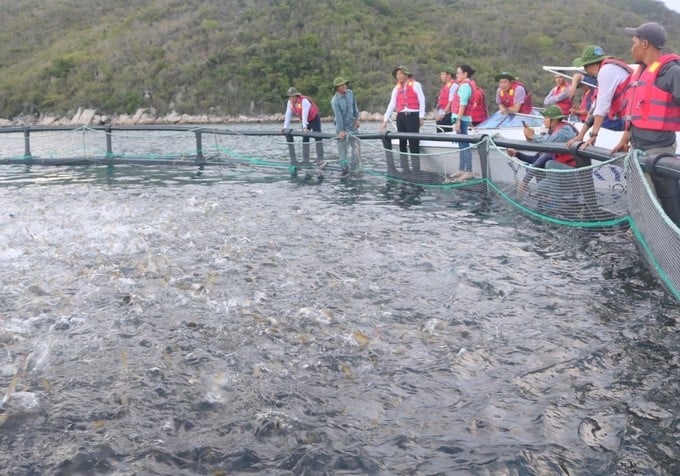
Vietnam is full of potential for marine aquaculture development. Photo: KS.
Vietnam has great potential for industrial marine aquaculture. In addition to its large area with usability up to about 500,000 ha (including landlocked embayment areas, tidal flats on the coast and partly on islands, and offshore waters), Vietnam also has a suitable climate for marine farming.
Vietnam’s development orientation toward marine aquaculture has been clearly shown in the Prime Minister's Decision No. 339 on approving the "Strategy for Development of Vietnam's Fisheries by 2030 with a vision to 2045" and the Prime Minister’s Decision No. 1664 on approving the "Project on Development of Marine Aquaculture to 2030 with a vision to 2045."
Accordingly, the overall goal of the project is to develop marine aquaculture into a large-scale, industrial, synchronous, safe, efficient, sustainable commodity production industry, protect the ecological environment, and create branded products.
By 2045, the marine aquaculture industry will reach an advanced level with modern management methods. The marine aquaculture industry has become an important part of the fisheries industry, contributing over 25% of the total output and having an export turnover of over USD 4 billion.
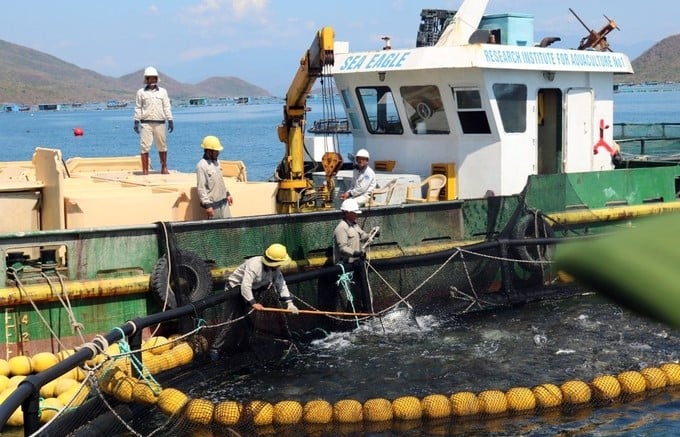
Raising trachinotus blochii with HDPE cages in Van Phong Bay, Khanh Hoa Province. Photo: KS.
According to the Department of Fisheries, developing marine aquaculture in Vietnam aims to create livelihoods and job opportunities for those who directly and indirectly participate in marine farming, live on the sea, or are closely associated with the sea. With harmonizing interests in the use of marine space.
At the same time, developing marine aquaculture aims to create a sub-sector of the integrated marine economy with higher value by applying modern marine farming technology solutions and catching up with the marine aquaculture industry in countries around the world. In particular, marine farming aims to shift from farming production thinking to economic thinking and from single-value growth to growth based on multi-value integration from marine resources.
To achieve these goals, it is necessary to reorganize the marine aquaculture industry in the spirit of cooperation, linkage, and person-centeredness.
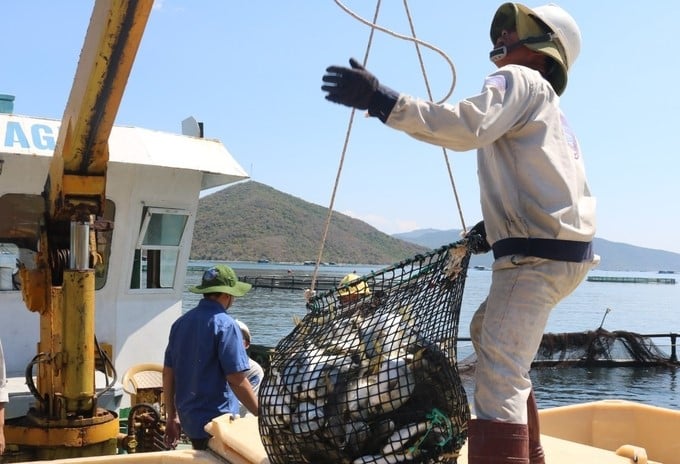
Human resources for industrial marine aquaculture are very necessary and important. Photo: KS.
According to Ms. Bui Thi Ninh, Director of the Bureau for Employer’s Activities in Vietnam of the Vietnam Chamber of Commerce and Industry (VCCI), Branch in Ho Chi Minh City, human resources serving the marine economy in general and industrial marine aquaculture in particular are still lacking. Moreover, most of the workers' production techniques are still at a low level and have not yet met the requirements of enterprises.
Meanwhile, the training program for industrial marine aquaculture has not been included in the formal training system. Therefore, it is very necessary to build a training model under the guidance of the industry to meet the labor demand of the market.
To do this, it is necessary to establish a cooperation mechanism between the state, schools, and enterprises in human resource development. In addition, the enterprises need to be proactive in participating in the training process in order to build a team of high-quality human resources with knowledge and skills to meet the practical needs of the industry, as well as create a solid foundation for advanced training on the working process.
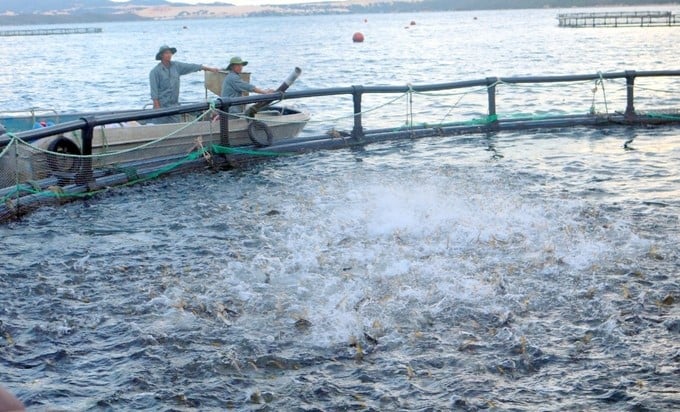
Currently, many localities have been promoting marine aquaculture on an industrial scale. Photo: KS.
According to the experts’ research and evaluation, Khanh Hoa, along with Quang Ninh and Kien Giang, are three localities with potential and advantages for developing marine aquaculture in Vietnam.
Mr. Le Van Hoan, Deputy Director of the Khanh Hoa Department of Agriculture and Rural Development, said that the province currently has some businesses and units using Norwegian cage technology to invest in marine farming in the direction of industry, such as Australis Aquaculture Vietnam Co., Ltd., High-Tech Aquaculture Center (Research Institute for Aquaculture No1), and Phuong Minh Aquaculture JSC.
In particular, Australis Aquaculture Vietnam Co., Ltd., which raises seabass on Van Phong Bay, has applied advanced farming technology such as operating an automatic feeding system, forming a closed chain from artificial seed production to the harvesting stage.
According to Mr. Le Van Hoan, along with other economic sectors, marine aquaculture in Khanh Hoa is aiming at industrial marine aquaculture, applying modern technology, and developing offshore with modern management methods. Since then, the marine aquaculture industry has become an important part of the province's agricultural sector, contributing to improving the province's production value and fisheries output.
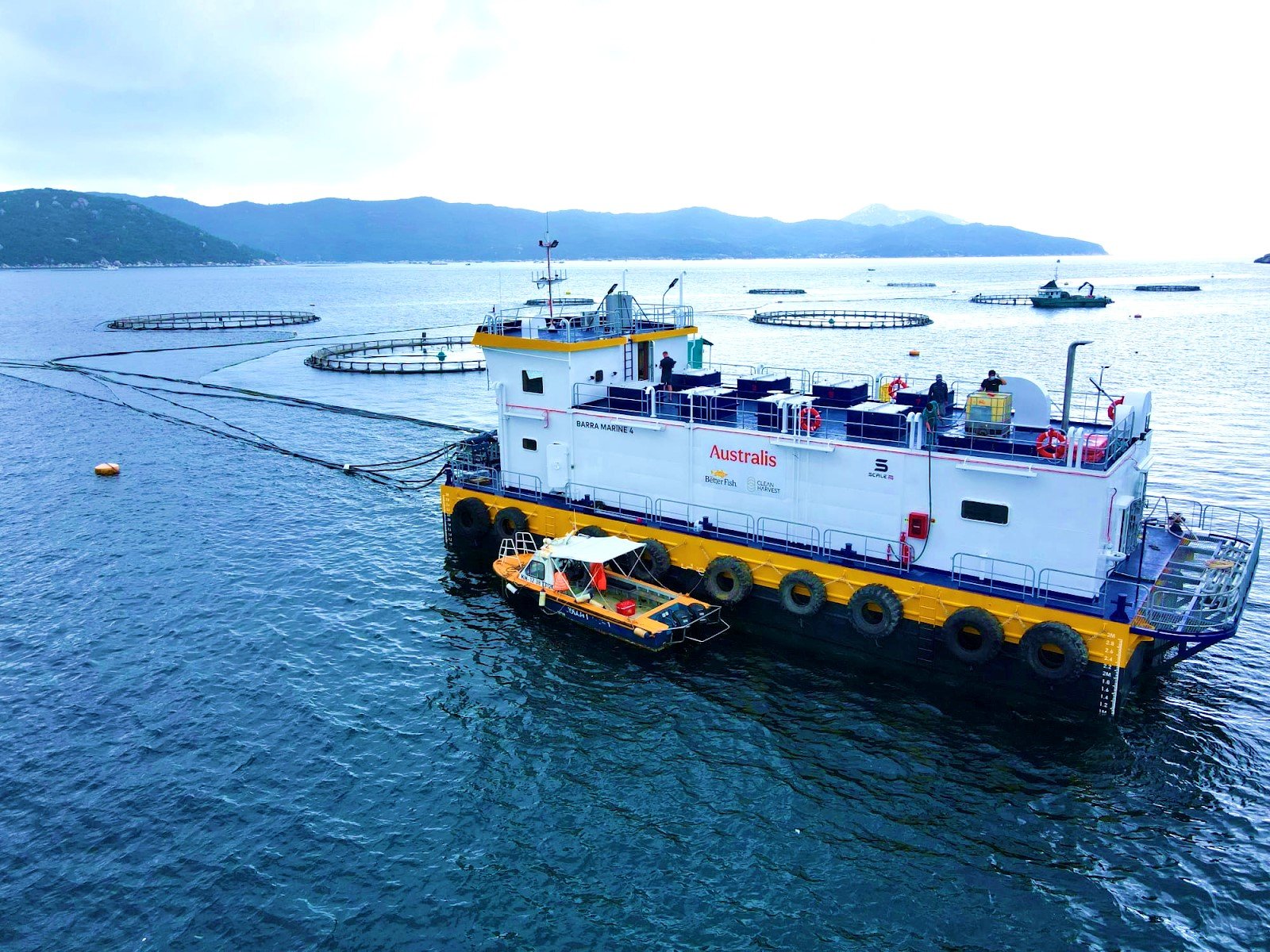
Aquaculture of Australis Aquaculture Vietnam Co., Ltd. Photo: Australis Vietnam.
Kien Giang is also a locality with a favorable location and great potential for marine resources. With more than 140 large and small islands and over 200km of the total length of the coastline (excluding surrounding islands).
According to the Provincial Department of Agriculture and Rural Development, in implementing the policy of the Provincial Party Committee and the People's Committee of Kien Giang province on attracting investment in marine aquaculture, Mavin Group, Australis Vietnam Company, Truong Phat Super Plastic Group JSC, etc. have surveyed and selected industrial marine farming areas concentrated in the Nam Du archipelago and other island communes in the province.
Also, according to the Kien Giang Department of Agriculture and Rural Development, in order to promote the province's potential and advantages in marine aquaculture as well as solve difficulties and limitations in marine aquaculture, the Provincial People's Committee issued Plan 123 dated June 17, 2021, on implementing the project on sustainable marine aquaculture development in the province by 2030.
The goal is to have about 7,500 farming cages by 2025, with an output of approximately 30,000 tons, while the mollusk farming area is about 25,500 ha, with an output of nearly 84,000 tons. By 2030, there will be 14,000 farming cages with an output of more than 100,000 tons and a mollusk farming area of nearly 27,000 ha with an output of 100,000 tons.
In addition, the province aims to develop marine aquaculture into an industrial-scale production field, creating a large volume of products for export, tourism, and domestic consumption. Transform small-scale marine farming models with outdated technology into large-scale models with modern and sustainable technology.
To achieve the set targets, Kien Giang province will continue to call on and attract capable businesses to invest in industrial marine aquaculture. Along with that, encouraging and supporting people and businesses to invest in scale and apply new farming cage technology with good resistance and the ability to raise offshore.
According to a representative of the Phu Yen Department of Agriculture and Rural Development, in the development orientation of industrial marine aquaculture, the province will plan an open sea area of about 1,000 ha in Song Cau town. The province will develop marine aquaculture in association with other economic sectors such as tourism, wind power, etc. The province also calls on enterprises to invest in industrial marine farming projects in the open sea in Hoa Loi village and Xuan Canh commune (Song Cau town) with a scale of 700 ha and an investment capital of VND 21,000 billion and implement two pilot projects on open marine farming (raising lobsters and sea fish) with HDPE cages by Dac Loc Seafood Company and Golden Shrimp Seafood Company.
Translated by Huyen Vu Thu
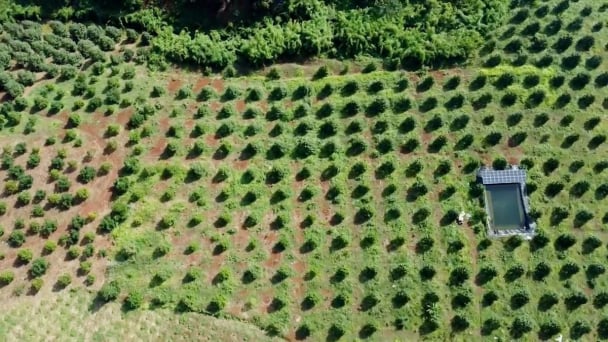
(VAN) Several scientists and farmers are experimenting with soil treatment in some key durian-growing regions such as Cai Lay (Tien Giang), Dak Song, Gia Nghia, and Dak R’lap (Dak Nong).
/2025/05/25/4127-3-073637_820.jpg)
(VAN) Thanks to the promotion from an FAO-implemented project, vegetable production in greenhouses in Moc Chau has seen strong development, from 1.5 hectares in 2021 to nearly 50 hectares in 2024.

(VAN) FAO has recently supported USD 140,000 to implement the project 'Risk mitigation human-animal interface risks through disease control initiatives in pig farming.'

(VAN) The People's Committee of Tra Vinh province has approved an adjustment to the investment policy for the Green Hydrogen Plant project, increasing its area to approximately 52.76 hectares.
![Reducing emissions from rice fields: [2] Farmers’ commitment to the soil](https://t.ex-cdn.com/nongnghiepmoitruong.vn/608w/files/news/2025/05/05/dsc08881jpg-nongnghiep-140632.jpg)
(VAN) Clean rice cultivation model in Thuong Tan commune, Bac Tan Uyen district, is assisting local residents in achieving sustainable agriculture by substantially reducing costs, increasing productivity, and protecting the environment.

(VAN) At the conference to disseminate Resolution No. 68, AgriS introduced its digital agricultural ecosystem and reaffirmed its commitment to accompanying the Government in promoting private sector development and sustainable agriculture.

(VAN) 'Blue Ocean - Blue Foods' initiative is designed to restore marine ecosystems and establish sustainable livelihoods for local communities by cultivating a minimum of 1,000 hectares of cottonii seaweed in the first three years.